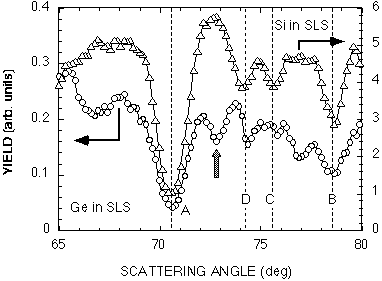
The Ge/Si heteroepitaxial system is great interest from the standpoints of both device application and fundamental science. The band structure in a strained-layer superlattice (SLS) is influenced by interface phenomena such as intermixing and strain distribution. Controlling the interface structure on an atomic level is therefore crucial. Nevertheless, our understanding of the structure of these SLSs is still insufficient. Using medium-energy ion scattering, we have studied interface structures between Si and Ge thin layers in GenSim SLS grown by molecular beam epitaxy.
In this system, the horizontal strain caused by lattice mismatch, further causes vertical atomic displacement. It is expected that the embedded Ge layers are compressed horizontally and expanded vertically compared with the ideal cubic crystal. However, MEIS blocking profiles (Fig. 1) indicate that the total strain of the 20 periods of Ge4Si12 SLS is smaller than the value calculated from the lattice mismatch (4%) between Si and Ge. It also exhibits a peculiar dip (displayed by the arrow in the figure), which could not be explained by simple vertical atomic displacement, in the blocking profile of scattered ions from embedded Ge layers. This additional blocking dip indicates that the Ge atoms are displaced not only vertically but also laterally. If the interfaces between Ge and Si layers had ideal abruptness, lateral displacement would be impossible because of the symmetrical bonding of Ge atoms. The exchanging between Ge and Si atoms, which is caused by segregation effect of Ge atoms during Si layer growth, makes lateral displacement possible. These lateral displacements reduce the vertical displacement, and the total vertical expansion of the SLS is restrained. In addition, the periodic structure at the interface is necessary to be observed the clear blocking dip. The existence of a 2xN periodic interface superstructure, as shown in Fig. 2, is suggested.
To summarize, the atomic structure of the interfaces in Ge4Si12 SLS has been decided experimentally from MEIS blocking profiles. Ge atoms at the interfaces are displaced both vertically and laterally, and a periodic interface superstructure makes the relaxation of the strain due to the lattice mismatch.

Fig. 1: MEIS blocking profiles for (Ge4Si12)20 SLS.

Fig. 2: Structural model of atomic displacements at the interface.